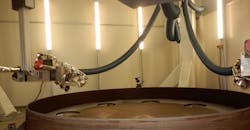Adding New Dimensions to Additive Manufacturing’s Growth
The first spark for additive manufacturing at IMTS was at the 2016 event, with multiple systems for metal 3D printing and hybrid manufacturing offered by major exhibitors and the initial appearance of the Additive Manufacturing Technology Pavilion in the West Hall of McCormick Place, Chicago. In fact the additive manufacturing (or 3D printing) has been in development for more than two decades, and the industrial sector shaped by this technology has grown exponentially in the six years since then – and manufacturers’ fascination and expectations are growing apace.
A recent analysis projected that the metal AM market will have consolidated annual growth (CAGR) of 18.8% through 2032, rising to a total market value of $18.5 billion. The demand is seen growing on the need for manufacturers to reduce the inventory of replacement parts, along with simplifying production of complex components, condensing supply chains, and accelerating product development times.
Factors driving metal AM growth
Among the factors driving growth for metal AM are lower-cost printers, an expanding portfolio of materials available for printing, plus innovations in printing technologies. Also, new printer developers/suppliers continue to be introduced, and more contract manufacturers are making their presence known to business in the market for prototype or short-run production.
All these factors will be guiding IMTS visitors to learn more about the evolution of additive manufacturing – including at the dedicated Additive Manufacturing Pavilion with over 55 exhibitors at IMTS 2022, one of nine dedicated technology centers to be staged among the hundreds of other exhibitors at the September 12-17 event in Chicago.
In addition to new possibilities, the AM pavilion will include demonstration of industrial challenges that already have been solved in ways that could not be imagined just a few years back, like 3D-printed components for NASA’s Artemis moon program.
“The pace at which AM technologies accelerate makes IMTS 2022 a must-attend event,” said Peter R. Eelman, vice president and CXO at AMT – the Association for Manufacturing Technology, which owns and produces IMTS. “Visitors will see AM solutions for production and high-volume part applications, tooling, workholding and fixturing that improve performance, lower lifecycle costs, and help reshore production. They’ll also be able to meet people pushing the boundaries of AM, including multiple technologies and components being developed for NASA.”
Benjamin Moses, director, technology at AMT, added: “IMTS exhibitors and AMT members have developed new additive systems with extremely large print volumes, yet they deliver the deposition precision and repeatability that NASA demands due to in-situ metrology and closed-loop controls.”
Among those developments are an 11-ft.-tall main rocket engine nozzle liner printed from JBK-75 (a stainless steel hydrogen-resistant superalloy), and a scanning electron beam microscope combined with an electron beam 3D metal printing system for replicating parts in space.
“Wire AM systems developed for aerospace parts are well-suited for tooling and other large components,” according to Moses. “In addition, modeling software developed to validate these concepts will help other industries build AM parts faster, at lower cost and with high quality.”
Technology team players
To create solutions for complex challenges, companies with AM solutions are collaborating to win contracts by coordinating with best-in-class technologies. For example, a team of subcontractors from Ingersoll Machine Tools using their MasterPrint® product and integration abilities (large-scale additive machines), Siemens (digital twin software), and MELD Manufacturing (the patented thermo-mechanical MELD® process) will help build the world’s largest metal 3D printer as part of U.S. Army’s Jointless Hull Program. That system will have a print volume of 20x30x12 ft. — large enough to print the next generation of main battle tank hulls and other combat vehicles, as monolithic hulls have well-established advantages for safety (survivability) and weight savings.
“Teamwork solved a real market problem, and that’s a great reason to attend a show like IMTS,” stated Jason Melcher, vice president of sales, Ingersoll Machine Tools, Inc. “From a collaboration standpoint, we attend conferences and trade shows specifically to listen to a particular technology presenter or visit a particular exhibit.”
He continued: “What we don’t know is who else we’ll meet at the show — yet we always find people with solutions that we haven't been able to even think about. Today, there’s too many problems and too many opportunities to tackle on our own. We as an industry need to find partners, and IMTS and its conferences are great venues for doing so.”
“The manufacturing economy has grown for 16 consecutive months, and the challenges manufacturers and job shops face have never been greater,” said Eelman. “The most efficient way to increase productivity per employee and create a lean supply chain is by implementing digital technologies such as additive manufacturing, and IMTS showcases the most complete breadth and depth of digital technologies available.”
